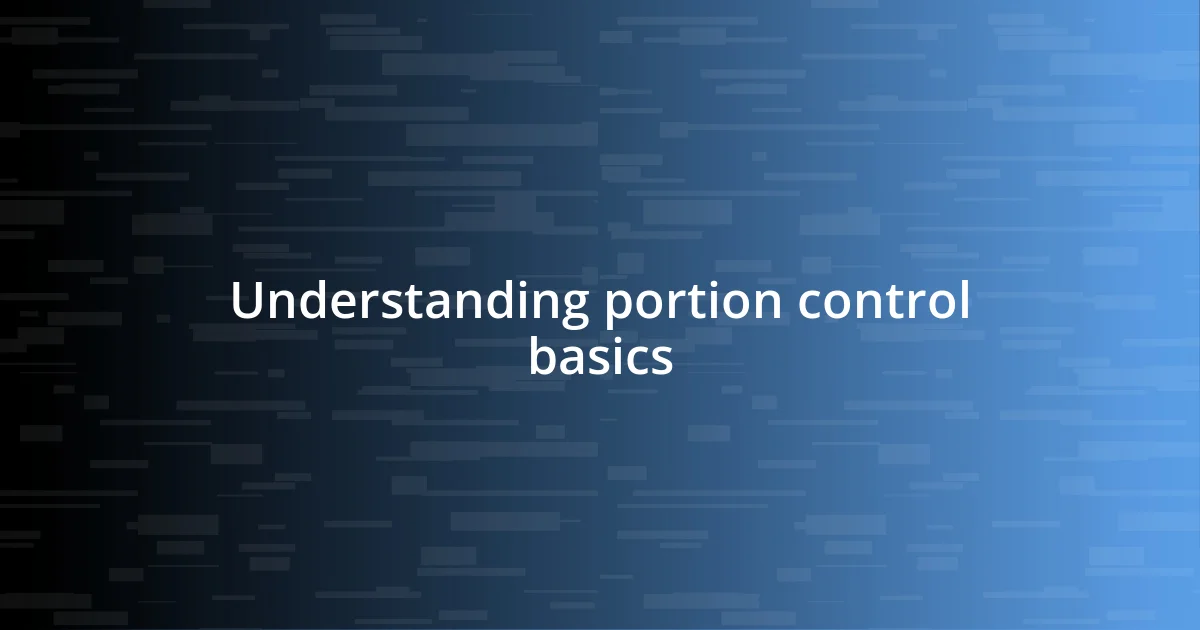Key takeaways:
- Portion control involves understanding and balancing food intake, allowing for enjoyment without feeling deprived, leading to increased meal satisfaction and energy levels.
- Utilizing strategies like smaller plates, visual cues, and mindful eating techniques can improve portion awareness and foster a deeper connection with food.
- Tracking portion sizes through measuring tools and self-reflection can enhance awareness of eating habits, encouraging healthier choices and limiting overeating.

Understanding portion control basics
Portion control is about finding the balance between enjoying food and managing how much we eat. I remember a time when I was surprised by how little I actually needed to satisfy my hunger. It’s not just about restricting ourselves; it’s about truly understanding our body’s signals and recognizing when we’re genuinely satisfied.
One common misunderstanding is that portion control equals deprivation, but that’s not the case. When I began to measure my portions with simple tools like a scale or measuring cups, it was eye-opening. I realized I was often serving myself double what my body required. Have you ever thought that those family-size bags of chips might just be designed to tempt us into eating more than we need?
Understanding the basic guidelines of portion sizes can make a significant difference in our eating habits. For instance, I like to visualize a plate divided into sections—half for vegetables, a quarter for proteins, and a quarter for grains. This simple mental image has not only helped me eat a balanced meal but also to slow down and savor my food. Isn’t it fascinating how a small shift in perspective can lead to healthier choices?

Importance of portion sizes
Understanding portion sizes is crucial for managing our overall health. When I first started focusing on how much I was eating, I felt liberated rather than restricted. It was a true revelation to see how the right portion could eliminate that uncomfortable, bloated feeling I often experienced after meals. I mean, who doesn’t want to enjoy food without feeling stuffed?
Talking about balance, there’s this notion that bigger portions equal more satisfaction, but I discovered it’s quite the opposite. I remember attending a dinner party where each dish was served family-style. I was tempted to pile my plate high, thinking more food would mean more enjoyment. However, by the end of the meal, I felt overwhelmed. I learned that savoring smaller portions allowed me to appreciate each bite, turning a simple meal into a delightful experience.
Portion sizes also play a vital role in maintaining energy levels throughout the day. In my own experience, I noticed that when I ate smaller, more balanced meals, my energy remained more stable. Have you ever felt the crash after indulging in a hefty plate? It’s a cycle I wanted to break. Now, with mindful portioning, I find I have more consistent energy and a clearer mind to tackle my day.
| Portion Control Concept | Benefits |
|---|---|
| Appropriate Portion Sizes | Enhanced meal satisfaction |
| Mindful Eating | Improved energy levels |
| Balanced Plate Method | Encourages nutrient diversity |

Strategies for measuring portions
Measuring portions accurately can feel daunting at first, but I’ve found a few strategies that have really simplified the process for me. For instance, I started using basic kitchen tools like measuring cups and a food scale, and honestly, what a game changer! When I prepare meals, I measure out ingredients, which not only helps with portion control but also enhances my cooking skills.
Here are some tips I’ve found effective in measuring portions:
– Use Visual Cues: Imagine your plate divided into sections. Think of it like a pie chart—half for veggies, a quarter for protein, and a quarter for grains.
– Choose Smaller Plates: It sounds simple, but using smaller dishes can trick your brain into feeling satisfied with less food.
– Pre-Portion Snacks: Instead of grabbing from bulk bags, I now pack snacks in small containers. This keeps me from mindlessly munching on more than I intend.
– Practice Mindful Eating: I’ve made it a habit to eat slowly and check in with my hunger levels throughout the meal. This helps me appreciate the food and realize when I’m full.
Incorporating these strategies into my daily routine wasn’t immediate, but that gradual shift was empowering. Once I began weighing my food, I realized I was overeating without even noticing it. It was enlightening to see how just a small portion could fill me up while allowing me to truly enjoy the flavors.

Mindful eating techniques
I’ve discovered that employing mindful eating techniques can completely transform one’s relationship with food. For instance, I started placing my phone aside during meals to truly engage with what I was eating. At first, it felt strange not to scroll through social media, but what I found was astonishing—the flavors became more vibrant, and I noticed textures I previously overlooked. It’s amazing how simply focusing on my plate can turn a meal into a sensory experience. Have you ever taken the time to fully savor each bite?
Another approach that has resonated with me is the practice of “chewing more.” I consciously try to chew each bite at least 20 times, which sounds like a lot, but it allows me to enjoy the nuances in every dish. Initially, it felt tedious, but soon it became a meditative practice. I noticed I not only ate slower but began to appreciate the food on a deeper level, feeling more satisfied without overeating. It’s curious how our bodies are designed to signal when we’re full; sometimes, we just need to give ourselves the chance to hear those signals.
One of my favorite techniques is incorporating gratitude into my mealtime. Before I take that first bite, I pause and think about where the food came from and the effort that went into it. I remember one day, as I picked fresh vegetables from my garden, I felt an overwhelming sense of appreciation. It reminded me that food is not just sustenance; it’s a connection to nature and myself. This practice not only enhances my meals but also helps me to eat with intention, fostering a sense of fulfillment that transcends the act of eating. What small changes might you make to foster a deeper connection with your meals?

Using smaller plates and bowls
Using smaller plates and bowls has been a revelation for me. When I switched to a salad plate for my meals, I felt like I was indulging in a feast, even though the portion was smaller. It surprised me how my mind adapted; I learned to appreciate the food on my plate rather than fixate on the quantity. Have you ever tried this method? When I see less on my plate, it encourages me to focus on the quality of what I’m eating, making each bite more enjoyable.
I remember hosting a dinner party where I decided to serve dessert in cute, little bowls instead of the standard plates. Not only did it prompt my guests to take smaller portions, but it also created a charming presentation that sparked conversations. Everyone seemed satisfied, and I couldn’t help but think about how such a simple change influenced our dining experience. Isn’t it fascinating how presentation and portion size can affect our perception of a meal?
As I think back on my experiences with smaller dishes, I find it’s not just about reducing portions; it’s about rewiring how I view food. Each meal now feels intentional, and I’m savoring every bite instead of mindlessly reaching for more. It’s a reminder that sometimes, the smallest changes can lead to the most profound transformations in our eating habits. What subtle shifts might you be tempted to try in your own dining experience?

Tracking portion sizes effectively
Tracking portion sizes effectively has been a game-changer in my journey toward mindful eating. At first, I relied on food diaries and apps, but I quickly discovered that simply measuring my food with a kitchen scale was far more enlightening. I remember one evening, I poured what I thought was a standard serving of pasta, only to realize it was nearly double the recommended size! It made me question how easily we can lose sight of portion control when we don’t take the time to measure. Have you ever had a similar revelation?
Another strategy that worked well for me is visual cues. I started using my hand as a guide; for instance, a serving of protein could be the size of my palm, while grains should fit in my cupped hand. This approach not only made it easier to estimate portions on the go, but it also allowed me to eat mindfully without feeling restricted. In one memorable instance, I found myself at a buffet; armed with this knowledge, I chose my favorites rather than loading up my plate indiscriminately. Suddenly, I felt in control, savoring each bite without guilt. Isn’t it liberating to find a balance between enjoyment and moderation?
Finally, I can’t emphasize enough how important it is to reflect on each meal after you eat. I developed the habit of jotting down notes about what I ate and how I felt afterward. This simple act brought a sense of awareness that changed my perception of portion sizes entirely. One day, I noted that I felt too stuffed after a family dinner, leading me to reconsider how much I was serving on my plate. Have you ever thought about how your meals affect your body and mind? This ongoing self-reflection transformed my approach to portion control, pushing me toward healthier choices and greater satisfaction from each meal.














